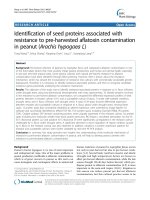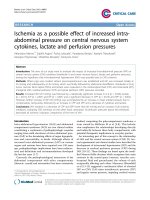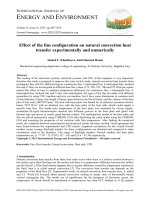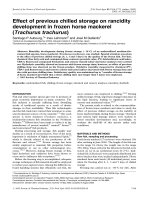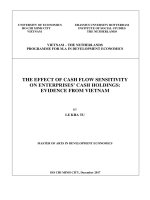Effect of charred rice husk on rainfed groundnut for water retention and nutrient management (Arachis hypogaea L.)
Bạn đang xem bản rút gọn của tài liệu. Xem và tải ngay bản đầy đủ của tài liệu tại đây (346.97 KB, 7 trang )
<span class='text_page_counter'>(1)</span><div class='page_container' data-page=1>
<i><b>Int.J.Curr.Microbiol.App.Sci </b></i><b>(2017)</b><i><b> 6</b></i><b>(11): 4123-4133 </b>
4123
<b>Original Research Article </b>
<b>Effect of Charred Rice Husk on Rainfed Groundnut for Water Retention and </b>
<b>Nutrient Management (</b>
<i><b>Arachis hypogaea</b></i>
<b> L.) </b>
<b>P. Balasubramanian* and C.R. Chinnamuthu </b>
Department of Agronomy, AC&RI, TNAU, Madurai, Tamil Nadu, India
<i>*Corresponding author </i>
<i><b> </b></i> <i><b> </b></i><b>A B S T R A C T </b>
<i><b> </b></i>
<i>International Journal of Current Microbiology and Applied Sciences </i>
<i><b>ISSN: 2319-7706 Volume 6 Number 11 (2017) pp. 4123-4133 </b></i>
Journal homepage:
A field experiment was conducted at the Department of Agronomy, Agricultural
College and Research Institute, Tamil Nadu Agricultural University, Madurai, Tamil
Nadu during 2014-2015 <i>rabi </i>season under rainfed situation to find out the effect of
charred rice husk and other organic materials enriched with or without fertilizer
nutrient on the moisture retention and nutrient supply during the deficit period of crop
growth. The field experiment was conducted with ten treatments, replicated thrice laid
out in randomized block design. Groundnut variety, VRI 2, a Spanish bunch type was
selected for the study and raised under sandy clay loam textured soil. The treatment
includes application of charred rice husk, biochar, lignite and farm yard manure alone
and enriched with the recommended dose of nitrogen (10 kg ha-1) and phosphorus (10
kg ha-1) fertilizer and compared with the absolute control and recommended dose of
fertilizer (10:10:45 kg NPK ha-1). The structural morphology of organic materials
were studied using Scanning Electron Microscope (SEM) showed that the particles of
charred rice husk were uneven and the diameter varied from 3-4 μm with clod and
block appearance. The particles of biochar were irregular in shape, uneven sized and
diameter varied from 2-3 μm with block appearance and the lignite particles found
spherical and aggregated. The chemical composition of intercalated manure with
nutrient examined under SEM-EDAX revealed that the charred rice husk contains
64.31 per cent carbon 28.42 per cent oxygen and 5.96 per cent silica. Whereas the
biochar composed of Carbon 66.65 per cent, nitrogen 6.58 per cent, oxygen 24.55 per
cent and silica 0.26 per cent and lignite comprised of carbon (63.64 per cent), nitrogen
(2.56 per cent), oxygen (24.96 per cent) and silica (1.25 per cent). The different
organic manures at the rate of 5 tons/ ha-1 was mixed with the calculated quantities of
urea and single super phosphate and incubated for 45 days. The nutrient loaded
organic manures were incorporated into the dry soil during land preparation. Total
amount of rainfall received during the entire crop growth period was 179 mm in
2014-2015. Data on crop growth characteristics revealed that, among various treatments;
enriched farm yard manure recorded higher values when compared to other
treatments. Application of enriched biochar and charred rice husk closely followed the
best treatment with respect to biometric parameters at all stages of crop growth.
Incorporation of enriched FYM at 5 t ha-1 recorded significantly higher pod yield
(2190 kg ha-1). The enriched biochar and charred rice husk produced comparable pod
yield of 2010 kg ha-1 and 1983 kg ha-1, respectively.
<b>K e y w o r d s </b>
Groundnut, Rainfed,
Enriched charred rice
husk, FYM, Lignite,
SEM-EDAX and
water retention
capacity.
</div>
<span class='text_page_counter'>(2)</span><div class='page_container' data-page=2>
<i><b>Int.J.Curr.Microbiol.App.Sci </b></i><b>(2017)</b><i><b> 6</b></i><b>(11): 4123-4133 </b>
4124
<b>Introduction </b>
Groundnut (Arachis hypogaea L.), the „King
of oilseeds‟ is an unpredictable legume, may
continue to be an important commercial crop
in rainfed areas. About 69 per cent of the
groundnut area is under rainfed generating
53.42 per cent of the total production
(Directorate of Economics and Statistics,
Department of Agriculture and Cooperation,
2009-10). The uncertainty of groundnut
productivity in the rainfed areas could be
minimized by <i>in situ conserving the soil </i>
moisture received through precipitation
during the cropping period and improving the
nutrient status.
Rice husk is the natural sheath or productive
cover, which forms the cover of rice grains
during their growth. Rice husk represents
about 20 per cent by the weight of the rice
harvested. About 80 per cent by weight of the
raw husk is made of organic components
(Anonymous, 1979) and incorporation of rice
husk into soil mixture was found to affect
many crops (Sharma et al., 1988).
Now days, Soil organic matter content is
gradually declining due to high cropping
intensity which causes quick decomposition
of organic matter. Use of rice husk as an
organic manure, might be play a vital role not
only in improving soil physical condition but
also in improving the plant nutrients.
Incorporation of rice husk can significantly
improve soil properties by decreasing soil
bulk density, enhancing soil pH, adding
organic carbon, increasing available nutrients
and removing heavy metals from the system,
ultimately increasing crop yields (Williams <i>et </i>
<i>al., 1972). Rice husk under different irrigation </i>
intervals can give good rice stand, better grain
yield and higher water use efficiency
(Abo-Soliman <i>et </i> <i>al., </i> 1990). The present
investigation was aimed to study the role of
enriched rice husk as an organic manure on
groundnut pod yield and water retention
capacity under rainfed condition.
<b>Materials and Methods</b>
Field experiment was conducted during <i>rabi </i>
2014-2015 under rainfed condition at the
Central Farm, Department of Agronomy,
Agriculture College and Research Institute,
Madurai, Tamil Nadu. The site was located at
90. 54‟ N latitude and 780.80‟ E longitude at
an altitude of 147 m above mean sea level.
The region falls under the southern zone of
Tamil Nadu. Field experiment was conducted
with ten treatments (Figure.2) replicated
thrice laid out in randomized block design.
The treatment includes application of charred
rice husk, biochar, lignite and farm yard
manure alone and enriched with the
recommended dose of nitrogen (10 kg ha-1)
and phosphorus (10 kg ha-1) fertilizer and
compared with the absolute control and
recommended dose of fertilizer (10:10:45 kg
NPK ha-1). The enriched organic manures
were prepared by taking each at the rate of 5
tons/ ha-1 and mixed thoroughly with the
recommended dose of urea and phosphorus.
The mixture was incubated for 45 days in
dark room. The procedure for loading nutrient
in the organic material is detailed below
(Figure.1).
</div>
<span class='text_page_counter'>(3)</span><div class='page_container' data-page=3>
<i><b>Int.J.Curr.Microbiol.App.Sci </b></i><b>(2017)</b><i><b> 6</b></i><b>(11): 4123-4133 </b>
4125
<b>Scanning electron microscope (SEM) study </b>
The scanning electron microscope (SEM) is a
type of electron microscope that images the
samples surface by scanning it with a
high-energy beam of electrons in a raster scan
pattern. Here, a wide range of magnifications
is possible, from 10 times (equivalent to that
of a powerful hand-lens) to more than 5,
00,000 times. All samples must be of an
appropriate size to fit in the specimen
chamber and are generally mounted rigidly on
a specimen holder called a specimen stub.
For taking images of sample, about 0.5 to 1.0
mg of sample was dusted on the carbon
conducting tape. Then the tape was mounted
on sample stage and the images were taken in
24,000X magnification and 15 to 30 KV
using FEI ESEM Model “QUANTA 250”
available in the Department of Nano Science
and Technology, Tamil Nadu Agricultural
University, Coimbatore. Energy Dispersive
X-Ray Spectroscopy (EDAX) is a chemical
micro analysis technique used in conjunction
with scanning electron microscopy (SEM).
For recording the chemical composition of
sample, about 0.5 to 1.0 mg of sample was
dusted on the carbon conducting tape.
<b>Water releasing pattern</b>
Water release pattern of different organic
manures were estimated by leaching columns
were constructed from commercially
available PVC plastic pipe (75 mm) with
suitable length of gap into the base assembly.
White colour nylon cloth was placed on the
base to prevent loss of fine materials. The
leaching water were pored to the columns
from plastic dropping funnels and collected
from the base of the columns in 500 ml
conical flask (James <i>et al., 2007).Other </i>
cultural practices was followed as
recommended by Tamil Nadu Agricultural
University, Tamil Nadu.
<b>Agronomic biometric observation and </b>
<b>analysis study</b>
Five plants were randomly selected from each
treatments to measure the agronomic
parameters. All data collected for
experimental purposes were statistically
analyzed by analysis of variance (ANOVA)
using AGRES (Data Entry Module for AgRes
Statistical software version 3.01, 1994 Pascal
Intl. Software Solutions). Differences
between mean values were evaluated for
significance using Least Significant
Difference (LSD) at 5 per cent probability
level as suggested by Gomez and Gomez
(1984).
<b>Results and Discussion</b>
The structural morphology of charred rice
husk, biochar and lignite were studied using
Scanning Electron Microscope (SEM) at low
and high resolutions. The porous rough
surface characteristic of organic materials
aided in loading of nitrogen and phosphorus
due to the physical adsorption and also by
covalent bonding with energy dispersive
X-ray spectroscopy (EDAX) (Fig. 3).The
chemical composition of intercalated manure
with nutrient was examined under
SEM-EDAX. The EDAX data confirmed the
composition of charred rice husk, biochar and
lignite.
<b>Growth characters </b>
</div>
<span class='text_page_counter'>(4)</span><div class='page_container' data-page=4>
<i><b>Int.J.Curr.Microbiol.App.Sci </b></i><b>(2017)</b><i><b> 6</b></i><b>(11): 4123-4133 </b>
4126
followed by enriched charred rice husk 5 tons
ha-1. However, no significant difference was
found between the enriched bio char and
enriched lignite at 5 tons ha-1 on plant height
(cm) and number of branches/plant on this
traits. The same trend was observed on leaf
area index. Aliyu <i>et al., (2011) reported that </i>
application of rice husk as a manures two
weeks before planting also produced the
highest number of leaves in cowpea
Chandrasekaran et al., (2007).
However, absolute control plots significantly
reduced the values of all the studied growth
attributes. This may be due to the decreasing
moisture content in root zone for a long
period, which adversely affected cell division,
elongation and vegetative growth. The
increase in branch number was attributed to
the gradual release of nutrients during
decomposition of manures (Budhar and
Palaniappan, 1994 and Budhar, 2003).
<b>Pod yield and yield components</b>
With respect of yield and yield components
such as, flowering percentage, number of
pegs, number of pods, number of matured
pods, single seeded pods and double seeded
pods and hundred pod weight were different
organic manures application plots Table (3).
The results indicated that highly significant
reduction was found in all the yield
components with respect to without organic
manures (absolute control plot), compared to
the different enriched organic manures
treatments Table (3). The results indicated
that, application of enriched farm yard
manure and enriched charred rice husk 5 tons
ha-1 yielded the highest biological and pod
yields respectively. Consequently, the
increase in pod yield components can be due
to the fact that available more water enhanced
nutrient availability which improved nitrogen
and other macro and micro elements
absorption as well as enhancing the
production and translocation of the dry matter
content from source to sink. Similar results
were reported by El Wehishy and Abd El
Hafez (1997), respectively. Okon <i>et al., </i>
(2005) stated that the optimum level of rice
husk plus 0.05 ton urea ha-1 can sustain rapid
growth and better yield of okra even faster
than NPK, because rice husk ash contains
almost all other essential plant nutrients and
the presence of nitrogen will boost their
uptake. The increase in both biological and
yields indicates that, rice husk already
decomposed and its nitrogen as well as other
nutrients was released to the plant,
furthermore, improved physical and chemical
soil properties could enhance the absorption
of native nutrients in the soil. Similar results
were found by Ebaid <i>et al., (2005). The </i>
increase in biological yield could be due to
the increase in yield attributes (plant height,
number of branches, leaf area index and
hundred pod weight) were stated Awad
(2001) and El Refaee et al., (2006). However,
no significant difference were found between
enriched bio char and enriched lignite at 5
tons ha-1.
On the other hand, without organic manures
recorded the lowest biological and pod yields.
These results revealed that the reduction in
yield components can be expected as plants
are exposed to water deficit. Besides,
available water enhanced the production and
transporting of dry matter content to the pod
yield resulting in more pod yield. This is in
agreement with results reported by Nour <i>et </i>
<i>al., (1996). </i>
<b>Nutrient uptake by crops</b>
</div>
<span class='text_page_counter'>(5)</span><div class='page_container' data-page=5>
<i><b>Int.J.Curr.Microbiol.App.Sci </b></i><b>(2017)</b><i><b> 6</b></i><b>(11): 4123-4133 </b>
4127
due to the role of different organic manures as
organic fertilizer on better holding the water
in the root zone. The reason might be due to
the increased root length and root volume
which might have tapped the available
nutrients from rhizosphere at the increased
soil moisture level than non-application of
organic manure plots. The other reason could
be that the applied organics might have
created favorable physical, chemical and
microbial environment. Furthermore,
improved physical and chemical soil
properties could enhance the absorption of
native nutrients in the soil. (Ebaid <i>et al., </i>
2005). Gupta et al., (1988) reported that
available N content of the soil increased
significantly with increasing application of
FYM.
<b>Fig.1 </b>Procedure for enriched organic manures preparation
Charred rice husk loaded with urea at the recommended dose and mixed thoroughly
↓
Further the single super phosphate at the recommended dose mixed with Charred rice husk
↓
Covered with Tar paulin and incubated for 45 days at room temperature
↓
Resulted in enriched manure with nitrogen and phosphorus
<b>Fig.2 </b>Treatments Details
<b>T1</b> - Charred rice husk+100 % recommended dose of N and P through soil application
<b>T2</b> - Biochar + 100 % recommended dose of N and P through soil application
<b>T3</b> - Lignite +100 % recommended dose of N and P through soil application
<b>T4</b> - Farm yard manure + 100 % recommended dose of N and P through soil application
<b>T5</b> - Charred rice husk 5 tons ha-1
<b>T6</b> - Biochar 5 tons ha-1
<b>T7</b> - Farm yard manure 5 tons ha-1
<b>T8</b> - Lignite 5 tons ha-1
<b>T9</b> - Absolute Control
<b>T10</b> - Recommended dose of fertilizer (RDF) (10:10:45 kg NPK ha-1)
Note: Urea contains 46% N, Single super phosphate contains 16% P2O4 and 12% SO4 and Muriate of potash
</div>
<span class='text_page_counter'>(6)</span><div class='page_container' data-page=6>
<i><b>Int.J.Curr.Microbiol.App.Sci </b></i><b>(2017)</b><i><b> 6</b></i><b>(11): 4123-4133 </b>
4128
<b>Fig.3 </b>Scanning Electron Microscope (SEM) of the size reduced charred rice husk a) 30 μm b) 10 μm resolution (SEM)
<i><b>Element</b></i> <i><b>Wt %</b></i> <i><b>At %</b></i> <i><b>Element</b></i> <i><b>Wt %</b></i> <i><b>At %</b></i> <i><b>Element</b></i> <i><b>Wt %</b></i> <i><b>At %</b></i>
<i><b>C K</b></i> 64.31 72.59 <i><b>C K</b></i> 66.65 72.87 <i><b>C K</b></i> 63.64 72.07
<i><b>O K</b></i> 28.42 24.09 <i><b>N K</b></i> 03.58 06.17 <i><b>N K</b></i> 01.56 02.49
<i><b>SiK</b></i> 05.96 02.88 <i><b>O K</b></i> 24.55 20.15 <i><b>O K</b></i> 24.96 21.22
<i><b>P K</b></i> 00.20 00.09 <i><b>NaK</b></i> 00.08 00.04 <i><b>NaK</b></i> 00.49 00.29
<i><b>S K</b></i> 00.24 00.10 <i><b>SiK</b></i> 00.26 00.12 <i><b>AlK</b></i> 05.32 02.68
<i><b>K K</b></i> 00.25 00.09 <i><b>P K</b></i> 00.23 00.10 <i><b>SiK</b></i> 01.05 00.51
<i><b>CaK</b></i> 00.25 00.08 <i><b>S K</b></i> 00.30 00.12 <i><b>P K</b></i> 00.22 00.09
<i><b>MnK</b></i> 00.23 00.06 <i><b>K K</b></i> 00.43 00.14 <i><b>S K</b></i> 00.61 00.26
</div>
<span class='text_page_counter'>(7)</span><div class='page_container' data-page=7>
<i><b>Int.J.Curr.Microbiol.App.Sci </b></i><b>(2017)</b><i><b> 6</b></i><b>(11): 4123-4133 </b>
4129
<b>Table.1 </b>Soil properties of the experimental sites before sowing and chemical composition of
charred rice husk sample
<b>Soil sample</b> <b>Charred rice husk</b> <b>Biochar</b> <b>Lignite </b>
Properties 2014-2015 Nutrient content (Per cent)
Clay (Per cent) 21.45 Carbon 64.31 66.65 63.64
Silt (Per cent) 9.05 Oxygen 28.42 24.55 24.96
Bulk density (g cm3) 1.38 Nitrogen 0.2 3.58 1.56
Particle density (g cm3) 2.08 Phosphorus 0.20 0.23 0.22
Available soil moisture (mm/60 cm) 101.05 Potassium 0.25 0.43 0.36
Field capacity (Per cent) 20.07 Calcium 0.25 0.63 0.78
Available N kg ha-1 (Subbiah and Asija, 1956) 154.00 Sulphur 0.24 0.30 0.61
Available P kg ha-1 (Olsen <i>et al.,</i> 1954) 20.00 Manganese 0.23 0.00 0.00
Available K kg ha-1 (Stanford and English, 1949) 195.00 Iron 0.15 0.00 0.00
Organic carbon (per cent) (Walkley and Black, 1934) 0.44 zinc 0.00 0.00 0.00
pH (1:2 soil water suspension) (Jackson, 1973) 7.50 Copper 0.00 0.00 0.00
Electrical conductivity (dSm-1) (1:2 soil water
suspension) (Jackson, 1973)
0.42
Silica 5.96 0.26 1.05
<b>Table.2 </b>Effect of enriched charred rice husk and other organic materials on Growth characters
<b>Treatments</b> <b>Plant height (cm)</b> <b>No. of branches/ plant-1</b> <b>Leaf Area Index</b>
T1 (CRH+NP) 48.59 11.84 4.60
T2 (BC+NP) 46.62 11.94 4.38
T3 (LN+NP) 43.16 11.07 4.16
T4 (FYM+NP) 52.49 13.15 4.89
T5 (CRH) 41.97 10.16 3.43
T6 (BC) 41.56 10.27 3.55
T7 (FYM) 42.98 10.53 4.01
T8 (LN) 39.00 10.04 3.23
T9 (Control) 36.04 7.92 2.87
T10 (RDF NPK) 44.34 11.24 4.66
<b>SEd</b> <b>1.08</b> <b>0.18</b> -
<b>CD (p=0.05)</b> <b>2.27</b> <b>0.39</b> -
<b>Table.3 </b>Effect of enriched charred rice husk and other organic materials on yield characters
<b>Treatments</b>
<b>Flowering </b>
<b>percentage </b>
<b>plant-1</b>
<b>Number </b>
<b>of pegs </b>
<b>plant-1</b>
<b>Number </b>
<b>of pods </b>
<b>plant-1</b>
<b>Number of </b>
<b>matured pods </b>
<b>plant-1</b>
<b>Single </b>
<b>seeded pods </b>
<b>plant-1</b>
<b>Double </b>
<b>seeded pods </b>
<b>plant-1</b>
<b>Hundred </b>
<b>pod weight </b>
<b>(g)</b>
T1 (CRH+NP) 8.50 28.81 23.19 19.78 3.10 16.79 101.27
T2 (BC+NP) 8.47 29.47 23.26 20.14 2.99 17.45 101.54
T3 (LN+NP) 7.84 26.67 20.08 17.09 2.13 14.51 100.03
T4 (FYM+NP) 9.16 31.78 25.77 22.97 3.11 20.22 102.95
T5 (CRH) 6.20 22.87 18.03 14.02 4.20 10.54 99.78
T6 (BC) 6.88 23.42 19.21 14.86 3.14 11.46 99.81
T7 (FYM) 7.24 24.16 20.48 16.24 4.01 11.78 100.01
T8 (LN) 6.16 21.84 16.94 12.40 4.00 8.27 98.83
T9 (Control) 5.16 15.70 11.41 9.56 4.65 5.84 97.23
T10 (RDF NPK) 7.60 27.48 21.48 16.21 3.57 13.72 100.48
<b>SEd</b> <b>0.17</b> <b>0.41</b> <b>0.47</b> <b>2.40</b> <b>0.07</b> <b>0.22</b> <b>NS</b>
</div>
<!--links-->
Báo cáo y học: "Birth order modifies the effect of IL13 gene polymorphisms on serum IgE at age 10 and skin prick test at ages 4, 10 and 18: a prospective birth cohort study" pps
- 13
- 427
- 0

